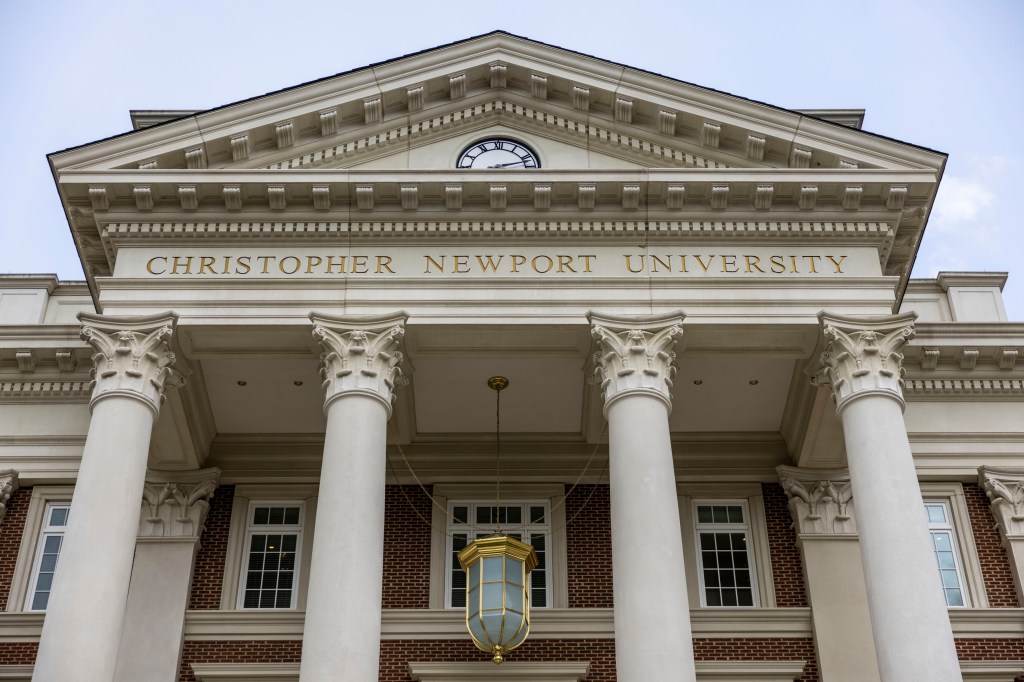Virginia
‘CNU was birthed out of racism’: Panelists discuss the history of CNU’s creation

NEWPORT NEWS — Historians, geographers and community leaders participated in a panel discussion examining the history of Christopher Newport University’s creation, and how it was built on land taken from a thriving Black community through the use of eminent domain.
In remarks before the event, President Bill Kelly said the university was in “listening and learning” mode.
CNU’s establishment in the 1960s on the Shoe Lane land that belonged to a small Black community has been a source of contention since its creation. Professor and historian Phillip Hamilton, who was one of Wednesday’s panelists, has written and talked about the events over the past 10 years. In 2019, the university created a park and erected a historic marker dedicated to William Walker Jr., one of the residents who led the opposition, according to school officials.

Rob Ostermaier / Daily Press
Newport News community and business leader William Walker Jr. was honored with a historical marker on the campus of Christopher Newport University on Friday September 20, 2019 where his home used to stand. The lawn will now be known as Walker’s Green.But the issue has again come to the forefront after an in-depth article published in September through a partnership between ProPublica and the Virginia Center for Investigative Journalism.
Other speakers on the panel included CNU geography professor John Finn; Norfolk State University professor and historian Cassandra Newby-Alexander; William Spencer, a pastor at First Baptist Church Morrison in Newport News; and Audrey Perry Williams, president of the Hampton Roads Association for the Study of African American Life and History.
Panelists said in the early ’60s, city officials chose the location for the university in an attempt to prevent plans to build a suburban housing development that would most likely draw more Black residents. Hamilton said historical records show that equally good land alternatives were available where the university could have been built without displacing the Shoe Lane community, and that the city tried to pay property owners less than what the land was worth.
Eminent domain, which is the power of governments to take private property for public use, has often been “weaponized” against Black communities and used to create de facto segregation, the panelists said. The pattern can also be seen in city planners’ targeting of Black neighborhoods for the expansion of Virginia Commonwealth and Old Dominion universities.
“The actual physical form of our cities is not random,” said Finn, who teaches a course on urban geography. “It was built this way to benefit someone. Who did it benefit? It benefited the people who had the power to shape the landscape in this way.
“And whether we know it or not, we live on the remnants of the unequal and historical processes, made real and made physical in the present. … Whether we know this history or not, we are implicated.”
The panelists also answered questions regarding ways to move forward. Though they expressed appreciation to the university for hosting the discussion as well as a scheduled community walk on Monday that will better acquaint students with the neighborhoods near campus, they said these steps are just a start.
Newby-Alexander said CNU should ensure no student graduates without taking a course focusing on the history of systemic racism. She said studying history is the first step to being able to heal and move forward.
“Only people who are trying to protect themselves don’t want to talk about the racism of the past, and American society has been essentially a racist society from the moment that English people walked onto this continent and started treating the indigenous populations as an obstacle,” she said. “So let’s be real about that.”
Finn said the university should also go past symbolic gestures and look at material actions. He pointed to other universities that have set up scholarship funds and began paying reparations to impacted families.
The panelists also said it was important to make the campus more friendly to Black and minority students. Williams said she’s heard from students of color who visited the campus and did not want to return.
“I don’t know what you’re doing, but it’s not working,” she said.
Spencer said what matters now is how the university will move forward.
“CNU was birthed out of racism, and it’s evident that it’s still here,” Spencer said.
Data shows that only about 7% of the university’s student body is Black.
“I’m looking for diversity and inclusion to not just be a word thrown around like a used toothpick, but to actually mean something,” Spencer said.
He said he’d like to see changes in hiring practices and the admissions process, and to make the university more reflective of the community around it.
“CNU, it’s time to do a new thing.”
Nour Habib, nour.habib@virginiamedia.com













You must be logged in to post a comment Login